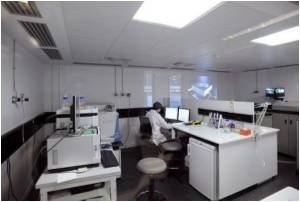An international team of scientists has discovered how an important natural antibiotic called dermcidin, produced by our skin when we sweat, is a highly efficient tool to fight tuberculosis germs and other dangerous bugs.
Their results could contribute to the development of new antibiotics that control multi-resistant bacteria.
Scientists have uncovered the atomic structure of the compound, enabling them to pinpoint for the first time what makes dermcidin such an efficient weapon in the battle against dangerous bugs.
Although about 1700 types of these natural antibiotics are known to exist, scientists did not until now have a detailed understanding of how they work.
The study, carried out by researchers from the University of Edinburgh and from Goettingen, Tuebingen and Strasbourg, is published in Proceedings of the National Academy of Sciences.
Sweat spreads highly efficient antibiotics on to our skin, which protect us from dangerous bugs. If our skin becomes injured by a small cut, a scratch, or the sting of a mosquito, antibiotic agents secreted in sweat glands, such as dermcidin, rapidly and efficiently kill invaders.
These natural substances, known as antimicrobial peptides (AMPs), are more effective in the long term than traditional antibiotics, because germs are not capable of quickly developing resistance against them.
The antimicrobials can attack the bugs’ Achilles’ heel – their cell wall, which cannot be modified quickly to resist attack. Because of this, AMPs have great potential to form a new generation of antibiotics.
Scientists have known for some time that dermcidin is activated in salty, slightly acidic sweat. The molecule then forms tiny channels perforating the cell membrane of bugs, which are stabilised by charged particles of zinc present in sweat. As a consequence, water and charged particles flow uncontrollably across the membrane, eventually killing the harmful microbes.
Through a combination of techniques, scientists were able to determine the atomic structure of the molecular channel. They found that it is unusually long, permeable and adaptable, and so represents a new class of membrane protein.
The team also discovered that dermcidin can adapt to extremely variable types of membrane. Scientists say this could explain why active dermcidin is such an efficient broad-spectrum antibiotic, able to fend off bacteria and fungi at the same time.
The compound is active against many well-known pathogens such as tuberculosis, Mycobacterium tuberculosis, or Staphylococcus aureus. Multi-resistant strains of Staphylococcus aureus, in particular, have become an increasing threat for hospital patients. They are insensitive towards conventional antibiotics and so are difficult to treat. Staphylococcus aureus infections can lead to life-threatening diseases such as sepsis and pneumonia. The international team of scientists hopes that their results can contribute to the development of a new class of antibiotics that is able to attack such dangerous germs.
Dr Ulrich Zachariae of the University of Edinburgh’s School of Physics, who took part in the study, said: “Antibiotics are not only available on prescription. Our own bodies produce efficient substances to fend off bacteria, fungi and viruses. Now that we know in detail how these natural antibiotics work, we can use this to help develop infection-fighting drugs that are more effective than conventional antibiotics.”
Source:Pharmabiz
Their results could contribute to the development of new antibiotics that control multi-resistant bacteria.
Scientists have uncovered the atomic structure of the compound, enabling them to pinpoint for the first time what makes dermcidin such an efficient weapon in the battle against dangerous bugs.
Although about 1700 types of these natural antibiotics are known to exist, scientists did not until now have a detailed understanding of how they work.
The study, carried out by researchers from the University of Edinburgh and from Goettingen, Tuebingen and Strasbourg, is published in Proceedings of the National Academy of Sciences.
Sweat spreads highly efficient antibiotics on to our skin, which protect us from dangerous bugs. If our skin becomes injured by a small cut, a scratch, or the sting of a mosquito, antibiotic agents secreted in sweat glands, such as dermcidin, rapidly and efficiently kill invaders.
These natural substances, known as antimicrobial peptides (AMPs), are more effective in the long term than traditional antibiotics, because germs are not capable of quickly developing resistance against them.
The antimicrobials can attack the bugs’ Achilles’ heel – their cell wall, which cannot be modified quickly to resist attack. Because of this, AMPs have great potential to form a new generation of antibiotics.
Scientists have known for some time that dermcidin is activated in salty, slightly acidic sweat. The molecule then forms tiny channels perforating the cell membrane of bugs, which are stabilised by charged particles of zinc present in sweat. As a consequence, water and charged particles flow uncontrollably across the membrane, eventually killing the harmful microbes.
Through a combination of techniques, scientists were able to determine the atomic structure of the molecular channel. They found that it is unusually long, permeable and adaptable, and so represents a new class of membrane protein.
The team also discovered that dermcidin can adapt to extremely variable types of membrane. Scientists say this could explain why active dermcidin is such an efficient broad-spectrum antibiotic, able to fend off bacteria and fungi at the same time.
The compound is active against many well-known pathogens such as tuberculosis, Mycobacterium tuberculosis, or Staphylococcus aureus. Multi-resistant strains of Staphylococcus aureus, in particular, have become an increasing threat for hospital patients. They are insensitive towards conventional antibiotics and so are difficult to treat. Staphylococcus aureus infections can lead to life-threatening diseases such as sepsis and pneumonia. The international team of scientists hopes that their results can contribute to the development of a new class of antibiotics that is able to attack such dangerous germs.
Dr Ulrich Zachariae of the University of Edinburgh’s School of Physics, who took part in the study, said: “Antibiotics are not only available on prescription. Our own bodies produce efficient substances to fend off bacteria, fungi and viruses. Now that we know in detail how these natural antibiotics work, we can use this to help develop infection-fighting drugs that are more effective than conventional antibiotics.”
Source:Pharmabiz












